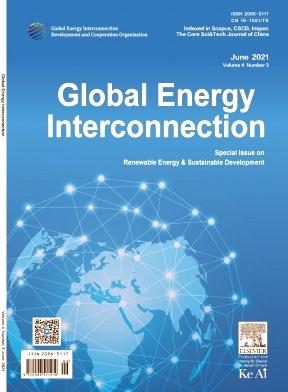考虑能源枢纽需求响应的有源配电网安全距离分析
IF 1.9
Q4 ENERGY & FUELS
引用次数: 0
摘要
本研究提出一种纳入能源枢纽(EH)需求响应的有源配电网(ADN)安全距离分析方法。考虑随机风力-太阳能发电和柔性负荷对EH的影响,建立了代表EH在这些影响下运行的交互功率模型。此外,构建了集成EH和柔性负荷的ADN安全距离模型,以评估柔性负荷变化对ADN安全距离的影响。考虑空调减载、基站转移等场景,A、B、C相安全距离分别增长17.1%、17.2%、17.7%。建立了多目标最优潮流模型,并采用前向-后向潮流算法、NSGA-II多目标优化算法和最大满意度法进行求解。IEEE33节点系统实例的仿真结果表明,优化后的ADN一天总能耗降低0.026%,三相总安全距离限制提高0.1 MVA。该方法有效地增大了安全距离,有利于BS负荷的转移和交流负荷的减少,有利于电力系统的节能、经济、安全运行。本文章由计算机程序翻译,如有差异,请以英文原文为准。
Security distance analysis of active distribution network considering energy hub demand response
This study proposes a method for analyzing the security distance of an Active Distribution Network (ADN) by incorporating the demand response of an Energy Hub (EH). Taking into account the impact of stochastic wind-solar power and flexible loads on the EH, an interactive power model was developed to represent the EH’s operation under these influences. Additionally, an ADN security distance model, integrating an EH with flexible loads, was constructed to evaluate the effect of flexible load variations on the ADN’s security distance. By considering scenarios such as air conditioning (AC) load reduction and base station (BS) load transfer, the security distances of phases A, B, and C increased by 17.1 %, 17.2 %, and 17.7 %, respectively. Furthermore, a multi-objective optimal power flow model was formulated and solved using the Forward-Backward Power Flow Algorithm, the NSGA-II multi-objective optimization algorithm, and the maximum satisfaction method. The simulation results of the IEEE33 node system example demonstrate that after optimization, the total energy cost for one day is reduced by 0.026 %, and the total security distance limit of the ADN’s three phases is improved by 0.1 MVA. This method effectively enhances the security distance, facilitates BS load transfer and AC load reduction, and contributes to the energy-saving, economical, and safe operation of the power system.
求助全文
通过发布文献求助,成功后即可免费获取论文全文。
去求助
来源期刊

Global Energy Interconnection
Engineering-Automotive Engineering
CiteScore
5.70
自引率
0.00%
发文量
985
审稿时长
15 weeks
 求助内容:
求助内容: 应助结果提醒方式:
应助结果提醒方式:


